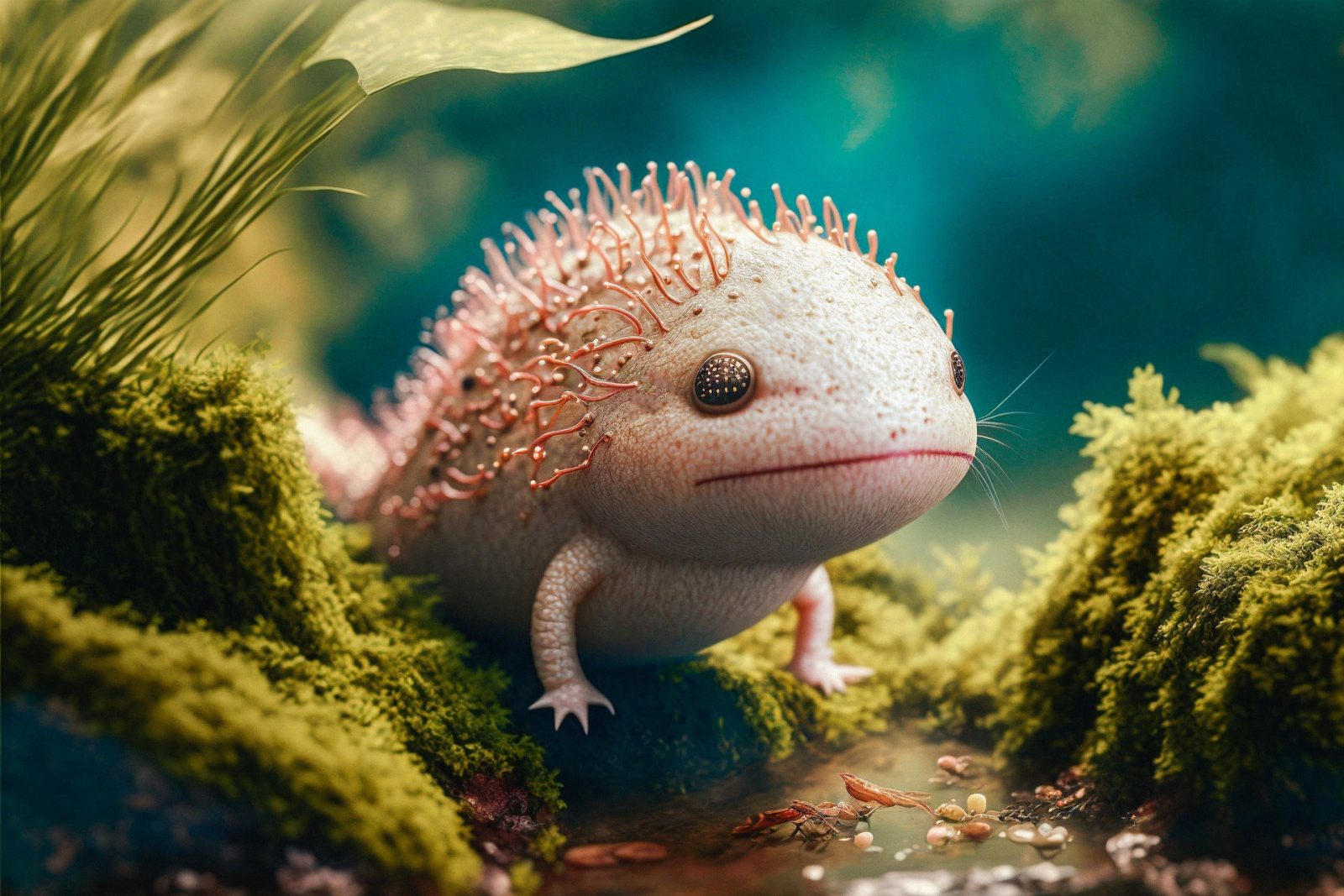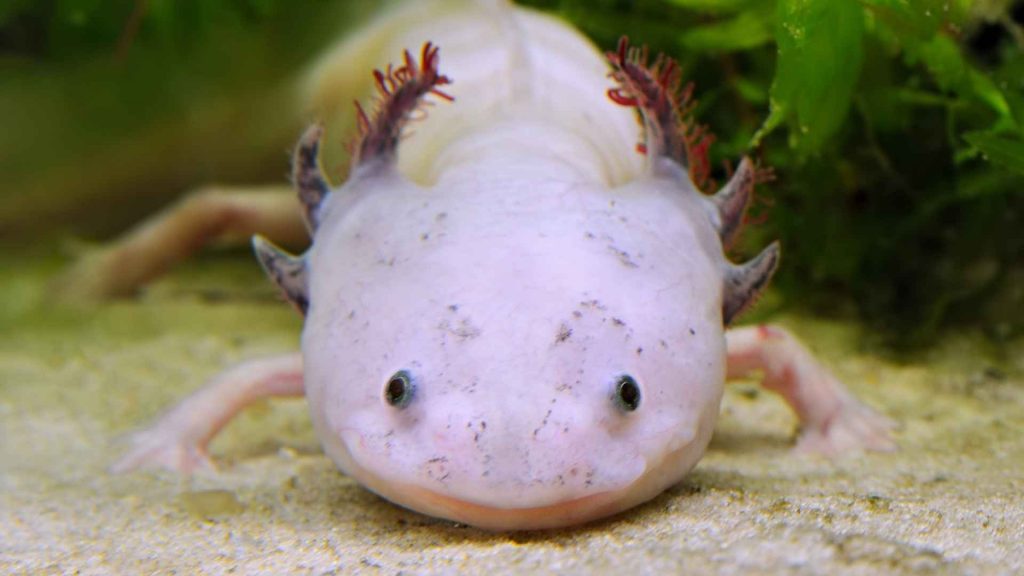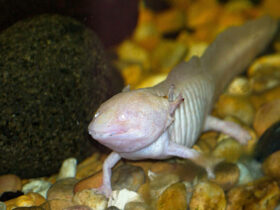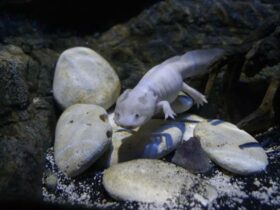
Contents
Do Axolotls Have To Live In Saltwater? – Introduction

Have you ever wondered if those adorable axolotls, with their feathery gills and permanent smiles, can survive in saltwater? You’reYou’re not alone. Many axolotl owners and enthusiasts debate whether these amphibians, native to the freshwater lakes of Mexico, can adapt to saltwater. The truth is axolotls are strictly freshwater salamanders. Their permeable skin and gills are suited to freshwater only. Saltwater would quickly dehydrate an axolotl and damage its sensitive gills.
While some amphibians have evolved to live in brackish water or even the ocean, axolotls have remained in their freshwater habitat for millions of years. Their unique characteristics, like retaining their larval features even into adulthood, are adaptations to a fully aquatic freshwater environment. So if you have an axolotl as a pet or are thinking of getting one, keep it in fresh, chlorine-free water. Axolotls and saltwater don’tdon’t mix!
Do Axolotls Need Salt? | How to Make Holtfreter’s Solution and Other Salt Recipes: https://m.youtube.com/watch?v=IEptV3djIk8&pp=ygUmRG8gQXhvbG90bHMgSGF2ZSBUbyBMaXZlIEluIFNhbHR3YXRlcj8%3D
Do Axolotls Have to Live in Saltwater? The Short Answer
No, axolotls do not have to live in saltwater. Axolotls are freshwater salamanders native to Lake Xochimilco in Mexico City. Saltwater would dehydrate and poison these little critters!
Axolotls thrive in fresh, dechlorinated water. You’llYou’ll want to use a water conditioner to remove any chlorine, chloramines and heavy metals before adding it to your axolotl’saxolotl’s tank. The ideal pH level for axolotls is between 6.5 to 8.0. Test your tap water to determine the pH and make adjustments as needed.
Axolotls also require a filter and cooler water temperatures, around 60 to 68°F. You can use an aquarium chiller, but frequently changing about 25% of the water weekly with fresh, dechlorinated water of the same temperature will also do the trick.
• Provide a secure mesh or glass lid for your axolotl tank since these amphibians can climb smooth surfaces and may jump out of an open tank!
• Include hiding spots, plants, driftwood, rocks, and other decor to stimulate your axolotl in their environment.
• Perform regular maintenance like algae scrubbing, filter cleaning and water testing to keep conditions healthy for your axolotl.
While axolotls may look like little aliens, they have basic needs like any pet. Your axolotl can live a long, happy and healthy life by setting up the proper freshwater environment. Keep your funny little friend out of salt water and in fresh, dechlorinated water for the best results!
Axolotls Are Freshwater Salamanders
Axolotls are freshwater salamanders, not saltwater creatures. They come from mountain lakes near Mexico City and thrive in fresh, cool water. Saltwater would seriously harm them.
Axolotls absorb water through their skin, and the high salt concentration in saltwater dehydrates them. Their gills are adapted for breathing freshwater and would get damaged in saltwater. Axolotls also have very sensitive skin that can get irritated by salt. Put, saltwater is toxic to these adorable amphibians.
Some may think axolotls live in saltwater because they resemble certain saltwater species like the sea dragon. But despite their feathery gills and fish-like tails, axolotls are 100% freshwater animals. They live their entire lives underwater, only coming up for air occasionally.
Use dechlorinated freshwater to keep your axolotl healthy and perform regular partial water changes. Please ensure any decorations in the tank are aquarium-safe since axolotls may try to eat them. Axolotls are carnivores, so feed them a diet of earthworms, feeder fish, crustaceans and commercial pellet food.
With the proper freshwater environment, nutrition, and care, axolotls can live 10-15 years and grow up to a foot long. These unique salamanders make fascinating and adorable pets, as long as you remember – no saltwater allowed! Keeping their water fresh is key to your axolotl’saxolotl’s health and happiness.
Why Saltwater Can Be Lethal to Axolotls
Axolotls are freshwater salamanders, not fish. They cannot survive in saltwater, and exposure to it can be lethal. Here’sHere’s why you should never put your axolotl in saltwater:
Osmotic Pressure
Axolotls live in freshwater their entire lives and are adapted to that environment. Their cells and organs function properly in freshwater. When placed in salt water, the higher salt concentration outside the axolotl’saxolotl’s body causes its cells to release water to equalize the concentration. This dehydrates the axolotl and disrupts its organ functions, which can lead to death.
Skin Damage
An axolotl’saxolotl’s skin and gills are permeable membranes adapted for life in freshwater. Saltwater will damage these membranes, causing the skin to crack and inflame gills. The excess salt can enter the axolotl’saxolotl’s body through these damaged sites, accelerating dehydration and organ failure.
Stress and Shock
Simply handling and moving an axolotl to a new enclosure filled with saltwater will stress the animal. The sudden environmental change and exposure to harmful salt will shock its system, weakening its immune response. This makes the axolotl even more susceptible to health issues from osmotic pressure changes and skin damage.
In summary, saltwater and axolotls do not mix. Their biology has evolved for life in freshwater, and exposure to saltwater, even briefly, can have devastating consequences. Always keep your axolotl in an enclosure filled with dechlorinated freshwater within its ideal temperature range. By providing the proper environment, your axolotl can live a long and healthy life as your aquatic companion.
Brackish Water Is Also Unsuitable for Axolotls
Axolotls are freshwater salamanders, not saltwater creatures. Their natural habitat is lakes and canals, not oceans. As amphibians, axolotls need to keep their skin moist and will dehydrate in saltwater.
Brackish Water Is Also Unsuitable for Axolotls
Brackish water has a higher salt concentration than freshwater, so it’s still unsuitable for axolotls. Low salinity levels, like 0.5-3%, can harm axolotls over time. Their skin and gills are adapted to freshwater, so the salt and minerals in salty water can damage these organs, causing problems like skin irritation, gill damage or even disease.
Providing your axolotl with brackish conditions will significantly reduce its lifespan and quality of life. As they are not native to brackish ecosystems, axolotls have not developed mechanisms to cope with these conditions. Their sensitive amphibious biology cannot handle it.
Some axolotl owners may be tempted to slowly acclimate their pet to brackish or even full marine conditions, thinking this will help them adapt. But axolotls cannot develop a tolerance for saltwater or truly adapt to these environments. At best, they can only temporarily cope through a stress response, ultimately threatening their health and shortening their life.
Axolotls are fully freshwater creatures. They should be kept in fresh, chlorine-free water with a neutral pH for their health, happiness and longevity. Brackish or saltwater environments are unsuitable and will jeopardize the well-being of your axolotl. If you want a saltwater pet, an axolotl is not the right choice. But if kept in the proper freshwater conditions, axolotls can live up to 15-20 years and make wonderfully engaging companions.
Providing the Right Freshwater Environment for Your Axolotl
Axolotls may look like amphibians, but they are fully aquatic salamanders. Unlike most amphibians, axolotls retain their larval features like gills for their entire lives and never undergo metamorphosis to live on land. Because of this, axolotls require a properly set up freshwater aquarium to thrive.
Providing the right environment for your axolotl starts with using a filtered aquarium of at least 20 gallons. Axolotls produce a lot of waste, so a filter is essential for keeping the water conditions healthy. An aquarium pump can also be used to provide water circulation and oxygenation. Since axolotls are native to lakes, aim for a pH between 6.5 to 8.0 and a water temperature of 60 to 68°F. Perform regular partial water changes of about 25% of the tank volume weekly using dechlorinated tap water or reverse osmosis water.
Axolotls also need certain substrates and decor in their aquarium. Avoid gravel, as axolotls can accidentally swallow it. Instead, use fine sand, slate, or bare bottom. Provide hiding spots, plants, driftwood, and other decor for your axolotl to explore. However, be careful not to place anything sharp in the tank that could injure your axolotl.
Never place axolotls in saltwater or brackish water. Axolotls are freshwater salamanders that will quickly dehydrate and die if placed in saltwater. Only provide fresh, dechlorinated tap water or reverse osmosis water in their aquarium. Perform regular water testing to ensure ideal conditions. The proper freshwater environment is key to keeping a healthy, happy axolotl.
Conclusion
So there you have it, the truth about axolotls and saltwater. These adorable salamanders are freshwater creatures through and through. While their distant relatives may have adapted to life in the ocean, axolotls stayed behind in lakes and streams. Their gills and skin can’tcan’t handle the salinity of saltwater. If you want to keep one of these smiling critters as a pet, stick with a freshwater aquarium. Axolotls can live long, happy lives with the proper freshwater conditions and diet. Who knew these strange little amphibians had such an interesting evolutionary story? Axolotls prove that you don’tdon’t have to adapt to change to be a successful species. Sometimes it pays to stay in your habitat.
More Links :
Do Axolotls Live Long? – Uncovering the Mystery of Axolotl Longevity
Are Blue Axolotls Real? – The Rarity of Blue Axolotls: Myth or Reality





Leave a Reply